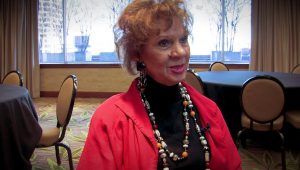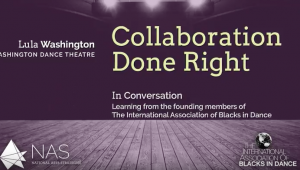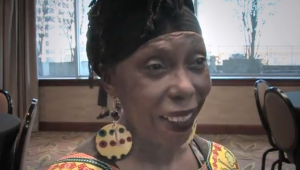We went together. For moral support. We knew nothing about suits. A gorges? What’s that. No one dared approach us. They stared, wondering why we were in this foreign land. We asked a gentleman to help us find a grey suit. He asked us what size the gentleman for which we were shopping was. Upon learning the actual intendant of this garment, the surprise on his face was so obvious any confidence we had quickly diminished. Nevertheless, he managed to point to a few that “might work for us.” We asked for a different size in a particular jacket. He trotted away to go and look for said jacket. Never to return. Too busy with folks fitting his idea of who should shop, buy and wear a suit. We’re used to it. We can fend for ourselves.
We headed toward the dressing room. The attendant responded to our request to try on with disturbance, “You?” We insisted. Her reply was met with an eye roll and, “Well, if you’re comfortable.” As if we were about to walk into an open room where men are changing together, high fiving and yeah bra-ing the best outfit. We took a breath of relief when we learned that, alas, it was simply private changing rooms.
We decided that there was something we’d purchase. We headed to another section to check out. We wanted nothing to do with those who wanted nothing to do with us. The man who rang up our items was lovely. We bonded over Morocco and the floral pattern we selected. He headed to get a garment cover for our purchase. From the suit section. He returned. A slight bit of concern on his face. The suit department was annoyed. All purchases should be rung in their section. Commission. The audacity. We laughed. They didn’t deserve it. If anyone did, it was this lovely gentleman who stood in front of us. This gentleman who returned, smiled even.
This company is highly rated on HRC’s corporate equality index. How? I am not sure. They seem to only support members of the LGBTQ community who fit the gender binary and traditional gender roles and expressions. This isn’t even the wedding industry. This is a commercial business. Things deepen inside an industry built around the long-standing tradition of seeing marriage valid only between man and woman.
Don’t get me started on vendors that have forms stating:
Bride’s name: __________
Groom’s name: _________
Words cannot begin to detail the emotional roller coaster of anxiety, anger, embarrassment that consumed me that afternoon, but this isn’t the only space or time I’ve felt this in my life. Not even close. In fact, it is so common that I expected it. I knew it was coming. And the wedding industry isn’t the only time in which we confront exclusionary spaces, forms or people.
Following the close of the annual American Alliance of Museums conference last month, the Welcoming Guidelines developed by the LGBTQ Alliance, a professional network of the American Alliance of Museums, passed through my Twitter feed – thanks to The Incluseum. As I read through, I squealed, spun around in my chair and smiled for a full hour. The Incluseum’s post on the guidelines asked, “What happens if LGBTQ and allied visitors arrive at an institution and face restrooms they don’t feel comfortable using, wayfinding or interpretive materials that render them invisible, or membership and program registration forms where they cannot accurately describe their own identities and the composition of their families?”
It is no surprise that the guide begins with these lines, “think of a time when you didn’t feel welcome.” As I read and re-read, I found myself thinking about this suit experience. About all the experiences I’ve had where I didn’t feel welcome, because I was holding the hand of a woman, or otherwise.
I can’t hold on to that negativity for too long, so I inevitably began to think of all of the places where I did feel I was welcome, wanted. Those are the spaces I want to create.
The guidelines state, “In order for LGBTQ persons to trust, attend and support museums generally, we need to see that institutions exhibit and obey ethical standards for making choices that are respectful to LGBTQ persons, families and interests.” It goes without saying, that I believe that this surpasses only the museum sector. As a person working in the field of arts and culture, I couldn’t be a more fervent advocate for bringing this thinking into all aspects of my work. Ask my colleagues how I constantly challenge our questions and policies in regards to gender and sexual orientation.
I can’t speak for the entirety of the LGBTQ community, but as a part of it, I can speak for myself. I do critique stores, brands and organizations for the exclusionary practices they either actively or passively practice. I do share these experiences with my peers, my colleagues, my family, and right now, the world. Arts organizations are not immune to this criticism.
I celebrate organizations like SOMArts, a leader in our sector in making the move to gender neutral restrooms and Transformer, for refusing to back down in the face of censorship and not only screen David Wojnarowicz’s Fire in my Belly but host public dialogue and ignite action.
I encourage you to not only continue to think about how you and the space you work in is welcoming, across the board, but to do something about it. Ask your team how you might make that question more gender inclusive. Ask your LGBTQ constituents how they feel when participating in that dance class. Ask and then do something about it.
In the wake of the tragedy in Orlando on Sunday, June 12 I am reminded that even our most sacred and safe spaces are threatened. We’ve come a long way, but being queer in public is still a radical act. Let us all remember how hate breeds violence and do our part to make this world a better and more welcoming place.


